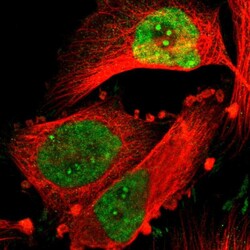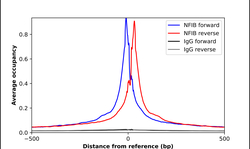Antibody data
- Antibody Data
- Antigen structure
- References [22]
- Comments [0]
- Validations
- Immunocytochemistry [1]
- Chromatin Immunoprecipitation [1]
Submit
Validation data
Reference
Comment
Report error
- Product number
- HPA003956 - Provider product page

- Provider
- Atlas Antibodies
- Proper citation
- Atlas Antibodies Cat#HPA003956, RRID:AB_1854424
- Product name
- Anti-NFIB
- Antibody type
- Polyclonal
- Description
- Polyclonal Antibody against Human NFIB, Gene description: nuclear factor I/B, Alternative Gene Names: NFI-RED, NFIB2, NFIB3, Validated applications: ChIP, ICC, WB, Uniprot ID: O00712, Storage: Store at +4°C for short term storage. Long time storage is recommended at -20°C.
- Reactivity
- Human
- Host
- Rabbit
- Conjugate
- Unconjugated
- Isotype
- IgG
- Vial size
- 100 µl
- Concentration
- 0.2 mg/ml
- Storage
- Store at +4°C for short term storage. Long time storage is recommended at -20°C.
- Handling
- The antibody solution should be gently mixed before use.
Submitted references TRIM71 reactivation enhances the mitotic and hair cell–forming potential of cochlear supporting cells
Cell-specific and shared regulatory elements control a multigene locus active in mammary and salivary glands
PTHrP induces STAT5 activation, secretory differentiation and accelerates mammary tumor development
The Polymorphic Nuclear Factor NFIB Regulates Hepatic CYP2D6 Expression and Influences Risperidone Metabolism in Psychiatric Patients
ASCL1 represses a SOX9+ neural crest stem-like state in small cell lung cancer
The NFIB‐ERO1A axis promotes breast cancer metastatic colonization of disseminated tumour cells
Redundant and non-redundant cytokine-activated enhancers control Csn1s2b expression in the lactating mouse mammary gland
Rlf–Mycl Gene Fusion Drives Tumorigenesis and Metastasis in a Mouse Model of Small Cell Lung Cancer
DCC regulates astroglial development essential for telencephalic morphogenesis and corpus callosum formation
Increased nuclear factor I/B expression in prostate cancer correlates with AR expression
Regionally Distinct Astrocytes Display Unique Transcription Factor Profiles in the Adult Brain
Region-Specific Transcriptional Control of Astrocyte Function Oversees Local Circuit Activities
Chromatin Decondensation by FOXP2 Promotes Human Neuron Maturation and Expression of Neurodevelopmental Disease Genes
YAP1 subgroup supratentorial ependymoma requires TEAD and nuclear factor I-mediated transcriptional programmes for tumorigenesis.
NFIB Mediates BRN2 Driven Melanoma Cell Migration and Invasion Through Regulation of EZH2 and MITF
Combined allelic dosage of Nfia and Nfib regulates cortical development
Nfib Regulates Transcriptional Networks That Control the Development of Prostatic Hyperplasia
A Genome-Wide Scan Identifies Variants in NFIB Associated with Metastasis in Patients with Osteosarcoma
PAX6 does not regulate Nfia and Nfib expression during neocortical development
NFIB-Mediated Repression of the Epigenetic FactorEzh2Regulates Cortical Development
MiR-153 targets the nuclear factor-1 family and protects against teratogenic effects of ethanol exposure in fetal neural stem cells
NFI Transcription Factors Interact with FOXA1 to Regulate Prostate-Specific Gene Expression
Li X, Morgan C, Nadar‐Ponniah P, Kolanus W, Doetzlhofer A
EMBO reports 2023;24(9)
EMBO reports 2023;24(9)
Cell-specific and shared regulatory elements control a multigene locus active in mammary and salivary glands
Lee H, Willi M, Liu C, Hennighausen L
Nature Communications 2023;14(1)
Nature Communications 2023;14(1)
PTHrP induces STAT5 activation, secretory differentiation and accelerates mammary tumor development
Grinman D, Boras-Granic K, Takyar F, Dann P, Hens J, Marmol C, Lee J, Choi J, Chodosh L, Sola M, Wysolmerski J
Breast Cancer Research 2022;24(1)
Breast Cancer Research 2022;24(1)
The Polymorphic Nuclear Factor NFIB Regulates Hepatic CYP2D6 Expression and Influences Risperidone Metabolism in Psychiatric Patients
Lenk H, Klöditz K, Johansson I, Smith R, Jukić M, Molden E, Ingelman‐Sundberg M
Clinical Pharmacology & Therapeutics 2022;111(5):1165-1174
Clinical Pharmacology & Therapeutics 2022;111(5):1165-1174
ASCL1 represses a SOX9+ neural crest stem-like state in small cell lung cancer
Olsen R, Ireland A, Kastner D, Groves S, Spainhower K, Pozo K, Kelenis D, Whitney C, Guthrie M, Wait S, Soltero D, Witt B, Quaranta V, Johnson J, Oliver T
Genes & Development 2021;35(11-12):847-869
Genes & Development 2021;35(11-12):847-869
The NFIB‐ERO1A axis promotes breast cancer metastatic colonization of disseminated tumour cells
Zilli F, Marques Ramos P, Auf der Maur P, Jehanno C, Sethi A, Coissieux M, Eichlisberger T, Sauteur L, Rouchon A, Bonapace L, Pinto Couto J, Rad R, Jensen M, Banfi A, Stadler M, Bentires‐Alj M
EMBO Molecular Medicine 2021;13(4)
EMBO Molecular Medicine 2021;13(4)
Redundant and non-redundant cytokine-activated enhancers control Csn1s2b expression in the lactating mouse mammary gland
Lee H, Willi M, Kuhns T, Liu C, Hennighausen L
Nature Communications 2021;12(1)
Nature Communications 2021;12(1)
Rlf–Mycl Gene Fusion Drives Tumorigenesis and Metastasis in a Mouse Model of Small Cell Lung Cancer
Ciampricotti M, Karakousi T, Richards A, Quintanal-Villalonga À, Karatza A, Caeser R, Costa E, Allaj V, Manoj P, Spainhower K, Kombak F, Sanchez-Rivera F, Jaspers J, Zavitsanou A, Maddalo D, Ventura A, Rideout W, Akama-Garren E, Jacks T, Donoghue M, Sen T, Oliver T, Poirier J, Papagiannakopoulos T, Rudin C
Cancer Discovery 2021;11(12):3214-3229
Cancer Discovery 2021;11(12):3214-3229
DCC regulates astroglial development essential for telencephalic morphogenesis and corpus callosum formation
Morcom L, Gobius I, Marsh A, Suárez R, Lim J, Bridges C, Ye Y, Fenlon L, Zagar Y, Douglass A, Donahoo A, Fothergill T, Shaikh S, Kozulin P, Edwards T, Cooper H, Sherr E, Chédotal A, Leventer R, Lockhart P, Richards L
eLife 2021;10
eLife 2021;10
Increased nuclear factor I/B expression in prostate cancer correlates with AR expression
Nanda J, Awadallah W, Kohrt S, Popovics P, Cates J, Mirosevich J, Clark P, Giannico G, Grabowska M
The Prostate 2020;80(13):1058-1070
The Prostate 2020;80(13):1058-1070
Regionally Distinct Astrocytes Display Unique Transcription Factor Profiles in the Adult Brain
Lozzi B, Huang T, Sardar D, Huang A, Deneen B
Frontiers in Neuroscience 2020;14
Frontiers in Neuroscience 2020;14
Region-Specific Transcriptional Control of Astrocyte Function Oversees Local Circuit Activities
Huang A, Woo J, Sardar D, Lozzi B, Bosquez Huerta N, Lin C, Felice D, Jain A, Paulucci-Holthauzen A, Deneen B
Neuron 2020;106(6):992-1008.e9
Neuron 2020;106(6):992-1008.e9
Chromatin Decondensation by FOXP2 Promotes Human Neuron Maturation and Expression of Neurodevelopmental Disease Genes
Hickey S, Berto S, Konopka G
Cell Reports 2019;27(6):1699-1711.e9
Cell Reports 2019;27(6):1699-1711.e9
YAP1 subgroup supratentorial ependymoma requires TEAD and nuclear factor I-mediated transcriptional programmes for tumorigenesis.
Pajtler KW, Wei Y, Okonechnikov K, Silva PBG, Vouri M, Zhang L, Brabetz S, Sieber L, Gulley M, Mauermann M, Wedig T, Mack N, Imamura Kawasawa Y, Sharma T, Zuckermann M, Andreiuolo F, Holland E, Maass K, Körkel-Qu H, Liu HK, Sahm F, Capper D, Bunt J, Richards LJ, Jones DTW, Korshunov A, Chavez L, Lichter P, Hoshino M, Pfister SM, Kool M, Li W, Kawauchi D
Nature communications 2019 Sep 2;10(1):3914
Nature communications 2019 Sep 2;10(1):3914
NFIB Mediates BRN2 Driven Melanoma Cell Migration and Invasion Through Regulation of EZH2 and MITF
Fane M, Chhabra Y, Hollingsworth D, Simmons J, Spoerri L, Oh T, Chauhan J, Chin T, Harris L, Harvey T, Muscat G, Goding C, Sturm R, Haass N, Boyle G, Piper M, Smith A
EBioMedicine 2017;16
EBioMedicine 2017;16
Combined allelic dosage of Nfia and Nfib regulates cortical development
Bunt J, Osinski J, Lim J, Vidovic D, Ye Y, Zalucki O, O’Connor T, Harris L, Gronostajski R, Richards L, Piper M
Brain and Neuroscience Advances 2017;1
Brain and Neuroscience Advances 2017;1
Nfib Regulates Transcriptional Networks That Control the Development of Prostatic Hyperplasia
Matusik R, Anderson P, Gronostajski R, Hayward S, Clark P, Miller N, Strand D, DeGraff D, Zhang J, Case T, Cates J, Reese A, Kelly S, Grabowska M
Endocrinology 2016;157(3):1094-1109
Endocrinology 2016;157(3):1094-1109
A Genome-Wide Scan Identifies Variants in NFIB Associated with Metastasis in Patients with Osteosarcoma
Mirabello L, Koster R, Moriarity B, Spector L, Meltzer P, Gary J, Machiela M, Pankratz N, Panagiotou O, Largaespada D, Wang Z, Gastier-Foster J, Gorlick R, Khanna C, de Toledo S, Petrilli A, Patiño-Garcia A, Sierrasesúmaga L, Lecanda F, Andrulis I, Wunder J, Gokgoz N, Serra M, Hattinger C, Picci P, Scotlandi K, Flanagan A, Tirabosco R, Amary M, Halai D, Ballinger M, Thomas D, Davis S, Barkauskas D, Marina N, Helman L, Otto G, Becklin K, Wolf N, Weg M, Tucker M, Wacholder S, Fraumeni J, Caporaso N, Boland J, Hicks B, Vogt A, Burdett L, Yeager M, Hoover R, Chanock S, Savage S
Cancer Discovery 2015;5(9):920-931
Cancer Discovery 2015;5(9):920-931
PAX6 does not regulate Nfia and Nfib expression during neocortical development
Bunt J, Lim J, Zhao L, Mason S, Richards L
Scientific Reports 2015;5(1)
Scientific Reports 2015;5(1)
NFIB-Mediated Repression of the Epigenetic FactorEzh2Regulates Cortical Development
Piper M, Barry G, Harvey T, McLeay R, Smith A, Harris L, Mason S, Stringer B, Day B, Wray N, Gronostajski R, Bailey T, Boyd A, Richards L
The Journal of Neuroscience 2014;34(8):2921-2930
The Journal of Neuroscience 2014;34(8):2921-2930
MiR-153 targets the nuclear factor-1 family and protects against teratogenic effects of ethanol exposure in fetal neural stem cells
Tsai P, Bake S, Balaraman S, Rawlings J, Holgate R, Dubois D, Miranda R
Biology Open 2014;3(8):741-758
Biology Open 2014;3(8):741-758
NFI Transcription Factors Interact with FOXA1 to Regulate Prostate-Specific Gene Expression
Grabowska M, Elliott A, DeGraff D, Anderson P, Anumanthan G, Yamashita H, Sun Q, Friedman D, Hachey D, Yu X, Sheehan J, Ahn J, Raj G, Piston D, Gronostajski R, Matusik R
Molecular Endocrinology 2014;28(6):949-964
Molecular Endocrinology 2014;28(6):949-964
No comments: Submit comment
Supportive validation
- Submitted by
- Atlas Antibodies (provider)
- Main image

- Experimental details
- Immunofluorescent staining of human cell line U-251 MG shows localization to nucleoplasm & nucleoli fibrillar center.
- Sample type
- Human
Supportive validation
- Submitted by
- Atlas Antibodies (provider)
- Main image

- Experimental details
- ChIP-Exo-Seq composite graph for Anti-NFIB (HPA003956, Lot 000053777) tested in K562 cells. Strand-specific reads (blue: forward, red: reverse) and IgG controls (black: forward, grey: reverse) are plotted against the distance from a composite set of reference binding sites. The antibody exhibits robust target enrichment compared to a non-specific IgG control and precisely reveals its structural organization around the binding site. Data generated by Prof. B. F. Pugh´s Lab at Cornell University.
 Explore
Explore Validate
Validate Learn
Learn Western blot
Western blot Immunocytochemistry
Immunocytochemistry